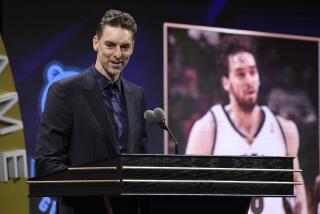Naismith Is Honored, 100 Years After the Fact
- Share via
SPRINGFIELD, Mass. — Somewhere in Brazil, the next Pele is shooting free throws.
If that is hard to imagine, it shouldn’t be. Although soccer remains the most popular sport in the world in terms of number of fans, there are more people in more places dribbling with their hands instead of their feet. Estimates indicate 250 million people in 176 countries are playing competitive basketball, and the game continues to grow at a staggering rate.
Dr. James Naismith is responsible. One hundred years ago, he picked up the soccer ball. Then he threw it into a peach basket. The rest, as they say, is history.
This weekend, the Basketball Hall of Fame and Springfield are celebrating the centennial Friday night, the game’s modern ambassadors, the Harlem Globetrotters, will embarrass a team at the Springfield Civic Center. At halftime, the finals of the YMCA Classic will be held, which is fitting: It was in America’s YMCAs where Naismith’s disciples went off to preach. Saturday brings a black-tie gala, the Basket Ball.
Thousands have poured into Springfield to pay homage to Naismith and his game, perhaps the only modern sport with roots so purely American. Curiously, Naismith was reared in Almonte, Ontario.
Growing up in lumber country, Naismith was a rugged lad. He frequently boxed on the way to school, and also participated in organized sports. Local legend says he invented “duck on a rock,” a game where the only requirements are a boy with a good arm, a rock and a fowl target.
Out of this, somehow, Naismith decided on the ministry. He attended McGill University in Montreal, and played football. “Football at the time was supposed to be a tool of the devil,” he wrote, “and it was much to my amusement that I learned that some of my comrades gathered in one of the rooms one evening to pray for my soul.”
Out of this, somehow, Naismith decided “to make athletics ... an avenue of preaching.” This led him to the Young Men’s Christian Association College, which later became Springfield College. Naismith played football there, too.
Classmate Amos Alonzo Stagg, who would find renown as a football coach, made the 160-pound Naismith the Springfield starting center.
At the conclusion of the 1891 football season, Naismith was charged with keeping a class of 18 prospective YMCA secretaries busy in the gymnasium. Tackle football does not mix well with hardwood flooring. Naismith had a problem.
“Dr. Luther Glick, head of the school, put the problem squarely up to me,” Naismith said.
Out of this, somehow, came basketball. As Naismith described the humble beginnings 52 years ago:
“I recalled from boyhood that when we played the game called duck on a rock, a hurled ball might send the duck farther, but a tossed ball (was) far more accurate. My new game, I decided, must have the ball tossed at the goal. Now, a goal on the floor would be too easy to guard, so I decided on a box above the floor. The janitor couldn’t find a box, but he offered a couple of peach baskets, which were nailed to the gymnasium railing. That rail was 10 feet from the floor. ...”
The secretaries said, “Just another game!” But when Naismith divided the squad and started the game, he said, “It took!” And the secretaries took it with them, fanning out to YMCAs all over the country. It became America’s winter sport, then the world’s.
Naismith later moved on to a YMCA in Denver, where he completed studies in medicine in 1898. He became the first basketball coach at the University of Kansas -- and the only one in Jayhawks’ history to finish with a losing record. He stayed in Lawrence 40 years as professor, chaplain and director of physical education.
“Strangely enough,” Naismith wrote, “though I was ordained as a Presbyterian minister and have an MD degree, I have never held a pastorate, nor have I put out a physician’s shingle.”
He died in 1939, leaving a game, and these words:
“I am sure that no man can derive more pleasure from money or power than I do from seeing a pair of basketball goals in some out of the way place--deep in the Wisconsin woods an old barrel hoop nailed to a tree, or a weatherbeaten shed on the Mexican border with a rusty iron hoop nailed to one end.”
More to Read
Sign up for Essential California
The most important California stories and recommendations in your inbox every morning.
You may occasionally receive promotional content from the Los Angeles Times.













